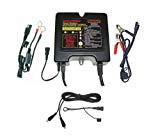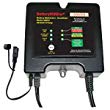Golf Cart Battery Sulfation – The #1 Cause of Battery Failure
Battery Sulfation – The number one cause of early golf cart battery failures
As a golfer, you know how important it is to have a reliable golf cart on the course. But have you ever encountered a problem with your golf cart’s battery? Chances are, it might be due to a common issue called sulfation.
Sulfation is a build-up of lead sulfate crystals on the plates of your golf cart battery, which can greatly affect its performance and lifespan. And trust me, we know from experience, replacing batteries can be costly. But, by understanding the causes and prevention of sulfation, you can save money and extend the life of your batteries.
We want to share our knowledge and experience with you, so you can keep your golf cart running smoothly for years to come.
Gain a better understanding of what sulfation is
By reading this article, you’ll gain a better understanding of what sulfation is, how it affects your golf cart batteries, and most importantly, how to prevent it. You’ll learn about the causes of sulfation and how to properly maintain your batteries to ensure they last as long as possible. This knowledge will not only save you money, but it will also give you peace of mind knowing that you’re doing everything in your power to take care of your golf cart. So, let’s dive in and learn more about sulfation and how to prevent it!
Batteries develop battery sulfation each time they are used (discharged – recharged). If they are overcharged, undercharged or left discharged for just a few days, they will rapidly develop sulfate.
It has long been known that a Golf Cart, as well as other application lead-acid batteries, sealed AGM or flooded (wet cell-filler caps), when used infrequently, lose power. In fact, they have shorter lives than those used on a more regular-daily basis.
How to prevent battery sulfation
However, it can be safely reversed, using high-frequency electronic pulses. Some people claim a battery will not develop sulfation if it is always kept fully charged. This is not correct. All lead-acid storage batteries will develop sulphate during their lifetime. This includes the new sealed “dry batteries”, such as Optima, Odyssey, Exide, and Interstate-branded AGM-spiral-wound types.

By doing so, otherwise healthy batteries, those which have lost no more than 20% of their power*, can expect improvement to an 85% or greater level of performance.
Amazon’s BatteryMINDer Battery Chargers
Prevention of battery sulfation beats rehab, every time.
With BatteryMINDers’ ability to fully charge, without ever overcharging, no matter how long left connected, there is no reason sulfation should ever become an issue.
Further, without sulfation ever reaching damaging levels and the battery never subjected to overcharging, life and performance can be expected to be several folds better than any battery left to self-discharge, as is typical of so many golf car batteries.
Testing Your Battery For Sulfation
The following, if done correctly, will tell you more about the condition of your battery.
Use a Digital Volt Meter and a hydrometer.

Step 1
Charge the battery to as full a level as possible with a charger. Allow the battery to “rest” which means don’t charge or discharge for a minimum of 12 hours.
Step 2
Measure the battery’s voltage using a digital meter. Record this reading. If your battery is a “wet cell” type (has filler caps) you can also test the Specific Gravity (SG) of the liquid electrolyte in each cell. Record the SG readings in each cell. For 48-Volt – minimum voltage for effective desulfation = 50.0 (wet cell SG reading 1265).
Amazon’s BatteryMINDer Battery Chargers
Step 3
Leave the battery connected to your BatteryMINDer for a period of 72 hours minimum.
Step 4
Disconnect and retest battery voltage and SG. You should measure an increase in the voltage and SG, indicating desulfation is taking place i.e. The sulfuric acid that was in the sulfate crystals has now returned to the electrolyte where it came from originally.
Step 5
Continue leaving the battery connected to BatteryMINDer for an additional 72 hours minimum and test again. Continue this testing until you no longer measure any improvement (increase) in the battery’s voltage (and SG, if wet cell).
Battery Sulfation Conclusion:
Battery Desulfation, via variable high-frequency pulses, dissolves sulfate from any type of sealed or wet cell lead-acid battery.
By doing so, otherwise healthy batteries, those who have lost no more than 25% of their power, can be expected to improve to 85% or greater level of performance.
Note: Increases in battery voltage and a wet battery’s electrolyte specific gravity, will be very small and depend on how sulfated the battery was, and how long the sulfate has been deposited on the storage plates.
Summary: Do you want your batteries to deliver the very best performance and have the longest possible life ? Then they must be kept free of sulphate by desulfating them in the safest, most effective way.
FAQ’s
Q: What is battery sulfation in golf carts?
A: Battery sulfation is a process where lead sulfate crystals build up on the battery plates, reducing the battery’s capacity and performance.
Q: What causes battery sulfation in golf carts?
A: Battery sulfation can be caused by a variety of factors, including overcharging, undercharging, leaving the battery in a discharged state for an extended period, and using a battery with low specific gravity.
Q: How can I prevent battery sulfation in my golf cart?
A: To prevent battery sulfation, it’s important to maintain proper charging and storage practices. Avoid overcharging or undercharging your battery, and keep it fully charged when not in use. Regularly check the specific gravity of the battery electrolyte and use a desulfator to remove any built-up sulfate crystals.
Q: Can a golf cart battery with sulfation be repaired?
A: It may be possible to repair a golf cart battery with sulfation by using a desulfator or a battery rejuvenator. However, if the battery is severely damaged, it may need to be replaced.
Q: How often should I check my golf cart battery for sulfation?
A: You should regularly check your golf cart battery for sulfation, ideally every month or whenever you notice a decrease in performance. Regular maintenance can help prevent sulfation and extend the lifespan of your battery.
Amazon’s BatteryMINDer Battery Chargers
Golf Cart Troubleshooting Tips
As an Amazon Associate, I earn from qualifying purchases. GolfCartBatteryChargerGuide.com is a participant in the Amazon Services LLC Associates Program, an affiliate advertising program designed to provide a means for sites to earn advertising fees by advertising and linking to Amazon.com,
Links on this battery sulfation page are sponsored affiliate links and the owner makes a commission if you buy after clicking these links. The owner has not had a problem with battery sulfation. However, he has thoroughly researched battery sulfation and provided a personal opinion only. This disclosure is in accordance with the Federal Trade Commission’s 16 CFR, Part 255: “Guides Concerning the Use of Endorsements and Testimonials in Advertising.”
